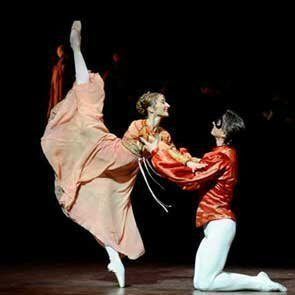The story of Romeo and Juliet was enormously popular even before Shakespeare took hold of it in 1595. The first recorded ballet was in 1785. Since there have been numerous dance versions. The most popular have been John Crankos and Kenneth MacMillans. The latter was created by Rudolf Nureyev and Margot Fonteyn in 1965 when she was 45 and he 27.
Nureyevs own version for English National Ballet, which premiered in 1977, has tended to be underrated and probably appeals more to audiences who enjoy dance theatre with a strong story line.
Nureyev sets his production firmly in Renaissance Italy, handsomely designed by Ezio Frigerio, and opens with four macabre figures gambling with dice, establishing that Fate will determine the deaths of the young lovers. This image is immediately followed by a tumbrel of corpses, victims of the Black Death.
The staging has theatrical flair. One of the most arresting images is of Death (a skeletal figure in a cloak) ravishing Juliet before Romeo has consummated the marriage. This image is inspired directly by Shakespeares text. Ill to my wedding bed, says Juliet, and death, not Romeo, take my maidenhead.
There are two clever ironic flash-forwards. The first is when Friar Lawrence explains to Juliet how his sleeping potion will lead to a happy ending. The second is when Romeo is in exile and he has an erotic dream about Juliet. There is also a striking visual interpretation of Juliets soliloquy when she does not know what she should do. The ghosts of Mercutio and Tybalt play a major part in her decision making. Tybalt (Fabian Reimair) tempts her with a dagger to kill herself, while Mercutio (Juan Rodriquez) offers her the potion.
One of the high spots is Mercutios death, which nobody on stage takes seriously. Earlier in the fight between him and Tybalt he had pretended to be mortally wounded. Now everybody thinks he is still playacting. His mates carry him round the market place, imitating a funeral cortege, and then give him a round of applause for his convincing performance
In the play Friar John is unable to deliver a vital letter to the exiled Romeo because of a curfew imposed by the city authorities on account of the plague. In the ballet he fails to reach Romeo because he is murdered on the highway.
A surprising and serious weakness is the finale, when the warring Capulets and Montagues are re-united. The scene is so perfunctory as to be meaningless
Daria Klimentova is heartbreaking in torment and death. Vadim Muntagirov, still only 20, is always lyrical and elegant, but never a randy adolescent. The emotion he expresses best is his grief when he learns of Juliets death from Benvolio (Max Westwell) and hurls himself backwards into his arms again and again. Serge Prokofievs music, as always, an essential component throughout, is dramatically thrilling.
